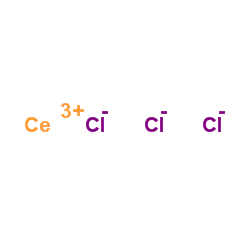537-00-8
| 中文名 | 醋酸铈(III)倍半水合物 |
|---|---|
| 英文名 | Cerium(Iii) Acetate Sesquihydrate |
| 中文别名 | 醋酸铈(III) |
| 英文别名 |
CERIUM(III) ACETATE SESQUIHYDRATE, 99.9% (REO)
Cerium(III) acetate sesquihydrate MFCD00051060 EINECS 208-654-0 |
| 沸点 | 117.1ºC at 760 mmHg |
|---|---|
| 熔点 | 308ºC |
| 分子式 | C6H9CeO6 |
| 分子量 | 317.24800 |
| 闪点 | 40ºC |
| 精确质量 | 316.94500 |
| PSA | 120.39000 |
| 外观性状 | 白色至黄色粉末 |
| 储存条件 | 储存于阴凉、干燥、通风良好的库房。远离火种、热源。防止阳光直射。包装密封。应与酸类、食用化学品分开存放,切忌混储。储区应备有合适的材料收容泄漏物。 |
| 稳定性 | 按规格使用和贮存,不会发生分解,避免与氧化物接触 |
| 计算化学 | 1.疏水参数计算参考值(XlogP):无 2.氢键供体数量:0 3.氢键受体数量:6 4.可旋转化学键数量:0 5.互变异构体数量:无 6.拓扑分子极性表面积120 7.重原子数量:13 8.表面电荷:0 9.复杂度:25.5 10.同位素原子数量:0 11.确定原子立构中心数量:0 12.不确定原子立构中心数量:0 13.确定化学键立构中心数量:0 14.不确定化学键立构中心数量:0 15.共价键单元数量:4 |
| 更多 | 1. 性状:未确定 2. 密度(g/ cm3, 16 ℃ ):未确定 3. 相对蒸汽密度(g/cm3,空气=1):未确定 4. 熔点(ºC):308 5. 沸点(ºC,常压):未确定 6. 沸点(ºC,8kPa):未确定 7. 折射率:未确定 8. 闪点(ºF):未确定 9. 比旋光度(º):未确定 10. 自燃点或引燃温度(ºC):未确定 11. 蒸气压(mm Hg,20ºC):未确定 12. 饱和蒸气压(kPa,55.1ºC):未确定 13. 燃烧热(KJ/mol):未确定 14. 临界温度(ºC):未确定 15. 临界压力(KPa):未确定 16. 油水(辛醇/水)分配系数的对数值:未确定 17. 爆炸上限(%,V/V):未确定 18. 爆炸下限(%,V/V):未确定 19. 溶解性:未确定 |
|
Section 1: Product Identification Chemical Name:Cerium (III) acetate, hydrate(99.9%-Ce) (REO) CAS Registry Number:537-00-8 Formula:Ce(OOCCH3)3.XH2O EINECS Number:208-654-0 Chemical Family:metal acetate salt Synonym:Acetic acid, cerium(3+) salt, cerium triacetate
Section 2: Composition and Information on Ingredients IngredientCAS NumberPercentACGIH (TWA)OSHA (PEL) Title Compound537-00-8100%no datano data Section 3: Hazards Identification Emergency Overview:Irritating to eyes, skin and respiratory tract. May be harmful if swallowed. Primary Routes of Exposure:Ingestion Eye Contact:Causes slight to mild irritation of the eyes. Skin Contact:Causes slight to mild irritation of the skin. Inhalation:Irritating to the nose, mucous membranes and respiratory tract. Ingestion:No information on the physiological effects of ingestion. Acute Health Affects:Irritating to skin, eyes and respiratory tract. Chronic Health Affects:No information available on long-term chronic effects. NTP:No IARC:No OSHA:No SECTION 4: First Aid Measures Immediately flush the eyes with copious amounts of water for at least 10-15 minutes. A victim may need Eye Exposure: assistance in keeping their eye lids open. Get immediate medical attention. Wash the affected area with water. Remove contaminated clothes if necessary. Seek medical assistance if Skin Exposure: irritation persists. Remove the victim to fresh air. Closely monitor the victim for signs of respiratory problems, such as difficulty in Inhalation: breathing, coughing, wheezing or pain. In such cases seek immediate medical assistance. Seek medical attention immediately. Keep the victim calm. Give the victim water (only if conscious). Induce Ingestion: vomiting only if directed by medical personnel. SECTION 5: Fire Fighting Measures Flash Point:not applicable Autoignition Temperature:none Explosion Limits:none Extinguishing Medium:carbon dioxide or dry powder If this product is involved in a fire, firefighters should be equipped with NIOSH approved positive pressure Special Fire Fighting Procedures: self-contained breathing apparatus and full protective clothing. Hazardous Combustion andIf involved in a fire this material may emit toxic and corrosive fumes. Decomposion Products: Unusual Fire or Explosion Hazards: No unusual fire or explosion hazard. SECTION 6: Accidental Release Measures Spill and Leak Procedures:Small spills can be mixed with powdered sodium carbonate or ground limestone and swept up. SECTION 7: Handling and Storage Handling and Storage:Store the material in a sealed container. Keep away from heat and moisture. SECTION 8: Exposure Controls and Personal Protection Eye Protection:Always wear approved safety glasses when handling a chemical substance in the laboratory. Skin Protection:Wear appropriate chemical resistant gloves and protective clothing. Ventilation:Material may form a fine dust. If possible, handle the material in an efficient fume hood. If ventilation is not available a respirator should be worn. The use of respirators requires a Respiratory Respirator: Protection Program to be in compliance with 29 CFR 1910.134. Ventilation:Material may form a fine dust. If possible, handle the material in an efficient fume hood. Additional Protection:No additional protection required. SECTION 9: Physical and Chemical Properties Color and Form:white powder Molecular Weight:317.26 Melting Point:no data Boiling Point:no data Vapor Pressure:no data Specific Gravity:no data Odor:none Solubility in Water:insoluble SECTION 10: Stability and Reactivity Stability:air and moisture stable Hazardous Polymerization:no hazardous polymerization Conditions to Avoid:none Incompatibility:oxidizing agents Decomposition Products:carbon monoxide, carbon dioxide, cerium oxide and organic fumes SECTION 11: Toxicological Information RTECS Data:Intravenous (human); TDLo: 2mg/kg Carcinogenic Effects:no data Mutagenic Effects:no data Tetratogenic Effects:no data SECTION 12: Ecological Information Ecological Information:No information available SECTION 13: Disposal Considerations Disposal:Dispose of according to local, state and federal regulations. SECTION 14: Transportation Shipping Name (CFR):Non-hazardous Hazard Class (CFR):NA Additional Hazard Class (CFR):NA Packaging Group (CFR):NA UN ID Number (CFR):NA Shipping Name (IATA):Non-hazardous Hazard Class (IATA):NA Additional Hazard Class (IATA):NA Packaging Group (IATA):NA UN ID Number (IATA):NA SECTION 15: Regulatory Information TSCA:Listed in the TSCA inventory SARA (Title 313):Title compound not listed. Second Ingredient:none SECTION 16 - ADDITIONAL INFORMATION N/A |
|
毒理学数据: 1、 急性毒性:人经静脉TDLo:2mg/kg,胃肠道-恶心或呕吐及其他变动,皮肤及附加物-出汗。 生态学数据: 该物质对环境可能有危害,对水体应给予特别注意。 CHEMICAL IDENTIFICATION
HEALTH HAZARD DATAACUTE TOXICITY DATA
|
| 危害码 (欧洲) | C |
|---|
|
~% 
537-00-8 |
| 文献:Journal of Inorganic and Nuclear Chemistry, , vol. 25, p. 201 - 203 |
|
~% 
537-00-8 |
| 文献:Monatshefte fuer Chemie, vol. 33, p. 243 |



